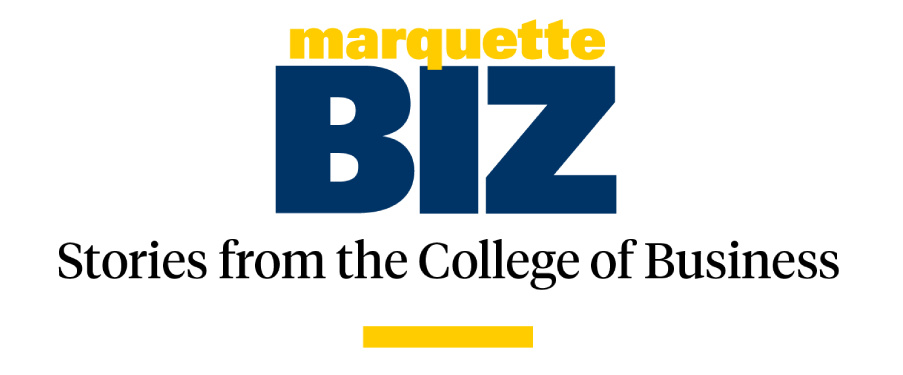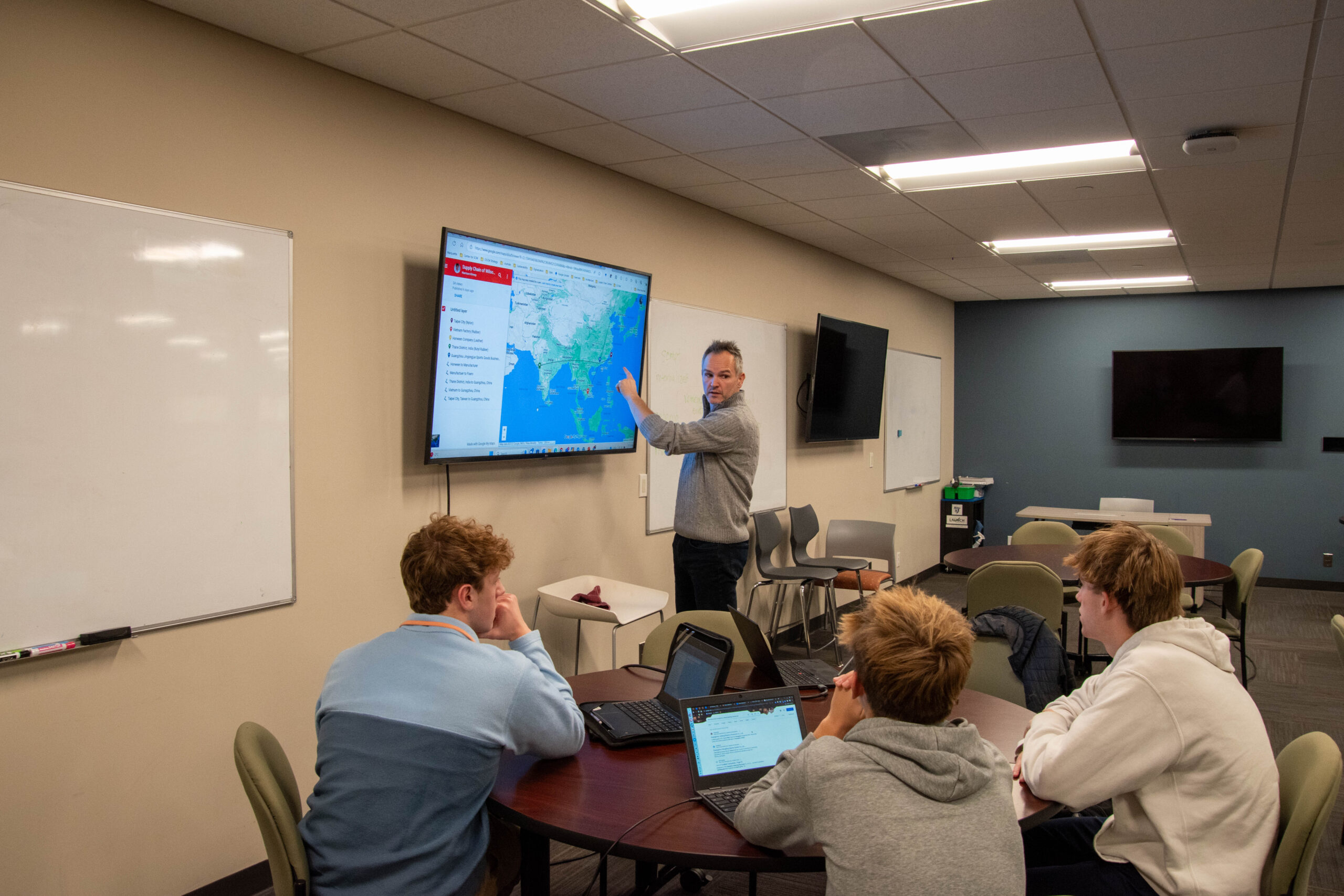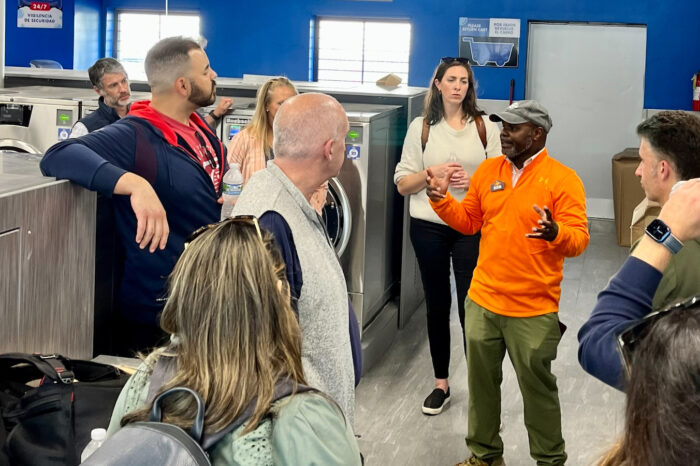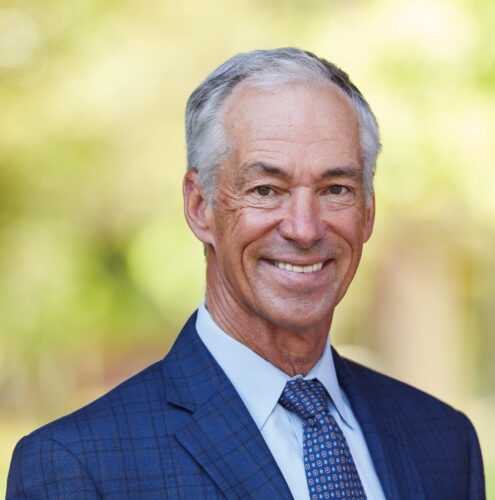Millions of NBA fans around the world have seen the iconic photo of Milwaukee Bucks all-star Giannis Antetokounmpo clutching a basketball with both hands, soaring above the floor for an alley-oop dunk against the Phoenix Suns to help deliver the team’s first league title since 1971.
While most people focus on Giannis or the defenders trying to stop him, Dr. Marko Bastl, associate professor of information systems, analytics and supply chain management, notices something else: the basketball itself. Specifically, how did it get to the arena? Where did it come from and who delivered it? What happens to it after the final buzzer sounds?
“When you try to find out the answers to these questions, it becomes very complex very quickly,” says Bastl, who is also the director of Marquette’s Center for Supply Chain Management.
Max Hansen, Harrison Kinney and Robert King, students in the Elmbrook Schools’ LAUNCH Program, recently got a unique look at the sorts of questions that make Bastl tick. LAUNCH, a program for high school juniors and seniors, provides students with an immersive educational experience that aims to develop skilled, adaptable, global innovators and leaders.
“It kind of surprised me how much negative impact on the environment a small thing like a basketball can have. If you think about how many basketballs are in use across the world, it’s really eye-opening.”
Harrison Kinney, Elmbrook School District student
Under Bastl’s leadership, the trio investigated the environmental sustainability of the NBA’s basketball supply chain, from the harvesting of rubber to the end of a ball’s useful life. Each Wednesday morning, Bastl and the students met at an offsite classroom to work through the problem step by step.
“Before I started this project, I didn’t know anything about how the supply chains for basketballs impacted the environment,” Hansen, a senior, says. “To think that this is just one product having these impacts on millions out there is pretty wild.”
Bastl first had the students map how basketball materials are sourced. The three identified what raw materials compose an NBA basketball and then used publicly available information to locate their sources. This discovery put them on a journey of mapping raw material supply chains across India, Taiwan, Vietnam and the United States. Ultimately, they traced the materials to an assembly facility in Guangzhou, China, where balls are sewn and then loaded deflated onto container ships for their trans-oceanic voyage.
Each step poses its own set of calculations that contribute to the supply chain’s total carbon footprint. In this project, students focused on evaluating transportation-related carbon emissions.
“It kind of surprised me how much negative impact on the environment a small thing like a basketball can have,” Kinney says. “If you think about how many basketballs are in use across the world, it’s really eye-opening.”
For Bastl, this is a chance to provide future college students a necessary education in supply chain principles. Students who study other business majors, such as accounting or finance, often arrive at college having at least baseline familiarity with their areas of study, either through school or in popular culture. Supply chain, on the other hand, is almost always a foreign concept to new students.
“The high school curriculum usually gives very little insight into the supply chain and logistics field, even though there’s a high demand for talent,” Bastl says. “What I’m doing here is placing a small stone into the larger mosaic of efforts to build awareness around the exciting opportunities in the area of supply chain management at an earlier age.”
The three students are promising candidates toward filling the talent gap. Hansen, a basketball fan, is a National Honors Society member who is considering Marquette. Kinney, while not a basketball fan, plays soccer and finds studying problems through a sports lens interesting. King plays three sports and is involved in the newspaper club. All have expressed interest in a future supply chain career.
Marquette Business has long been recognized as a leader in the field. In the latest U.S. News & World Report rankings, Marquette supply chain ranks 17th nationally. Class of 2022 graduates reported an employment rate of over 85 percent after six months, with a median starting salary at almost $70,000.
The Master’s in Supply Chain Management program also received a strong national ranking: it was ranked 17th by Gartner, a national technological research and consulting firm.
Whether or not the students go to Marquette or study supply chain, Bastl hopes they can sell the profession to their peers, stretching the project’s impact beyond the group’s few weeks together.
“How can we transition this from a few isolated projects to a broader curriculum? That’s something we’re talking a lot about,” Bastl says. “As a coach, I was surprised at how resourceful these students are and I’d love for others to get involved when they see the results of this project.”
With Bastl’s help, the students contacted sources to identify how a ball travels from the Port of Los Angeles to Milwaukee. They also figured out which parts of the ball are potentially recyclable and how the ball’s life cycle could be extended through donations to avoid landfilling.
It all led to the group’s final presentation in front of their friends, family and a panel of judges. The three summarized their findings and made recommendations for sustainability improvements around transportation mode, travel distances and experimentation with alternative materials. They also recommended upcycling the raw materials to form new products, reducing the overall carbon footprint.
Along the way, the students learned how valuable it was to speak the language of supply chains.
“You never know what you’re going to learn,” King says. “I knew it was going to be interesting, but it’s actually fun, too. A lot of people don’t have fun doing their homework, but we’re doing this for a genuine, real-world problem and I think that motivated us to work really hard.”




